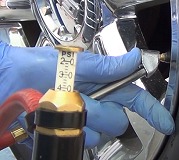Check if this apply to you
TYPICAL HIGH SPEED VIBRATIONS (ABOVE THAN 72 KM/H (45 MPH))
? Axle and companion flange runout or imbalance
? Driveshaft imbalance
? Excessive tire-wheel and drum assembly imbalance
? Tire roughness due to high non-uniformity (force variation) or out-of-balance condition
? Rear axle pinion gear pitch line runout
? Excessive tire and wheel runout
? Worn suspension components
? Front end accessory vibrations
? Exhaust vibration - Exhaust vibration is greatly reduced in Ranger exhaust systems de-coupled by a flexible coupling and mounted with blade and block hangers.
DRIVESHAFT VL8RATES
1. Road test vehicle to determine critical vibration points. Note road speed, engine rpm and shift lever positions at which vibration occurs. 2. Stop vehicle and run engine with clutch depressed (automatic transmission in Neutral) through critical speed ranges determined in Step 1 of Driveshaft Vibrates. 3. If vibration is gone, the driveshaft must be balanced as described in the 1997 Ranger Service Manual, Page 05-00-29.
COMPONENT TEST DRIVELINE VIBRATION
? Driveline vibration exhibits a higher frequency and lower amplitude than does high-speed shake.
? Driveline vibration is directly related to the speed of the vehicle and is usually noticed at speeds of 72 km/h (45 mph) or higher.
? Driveline vibration can be perceived as a tremor in the floor pan or is heard as a rumble, hum or boom.
? Driveline vibration can exist in all drive modes, but may exhibit different symptoms depending upon whether the vehicle is accelerating, decelerating, floating or coasting. If the vibration is particularly noticeable during acceleration or deceleration, especially at lower speeds, then driveline angle should be checked.
? Driveline vibration can be duplicated by supporting the axle upon a hoist or upon jackstands, though the brakes may need to be applied lightly in order to simulate road resistance. Refer to the 1997 Ranger Service Manual, Page 05-00-15, Steps 1-10.
DRIVELINE BOOM AT 20-65 MPH
Vibration or shudder which is noticeable either on fast acceleration, when coasting, or when using the engine for braking, may be caused by the rear axle housing being loose on the rear suspension, improper tire balance, improper driveline installation, or driveline balance.
If driveshaft components are replaced and shaft vibration is encountered after installation, disconnect and remove the driveshaft. Rotate the rear axle companion flange 180 degrees; then, reconnect the driveshaft to the driveshaft slip-yoke and reinstall in vehicle. If the vibration persists, disconnect the driveshaft at the rear axle companion flange. Rotate the rear axle companion flange 180 degrees and reconnect the driveshaft to the rear axle companion flange.
If rotating the driveshaft 180 degrees does not eliminate vibration, the driveshaft may be balanced by referring to the 1997 Ranger Service Manual, Page 05-00-29, Steps 1-9, for details
Saturday, February 28th, 2009 AT 5:53 AM


